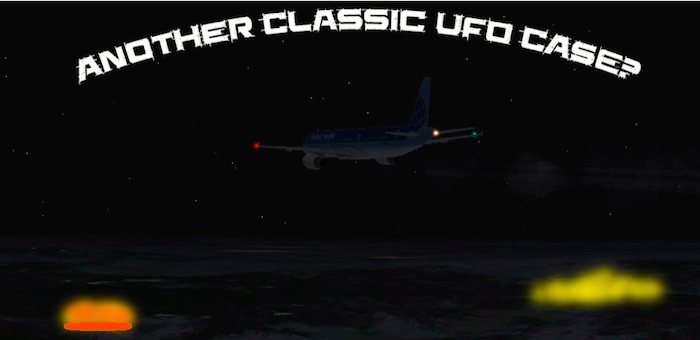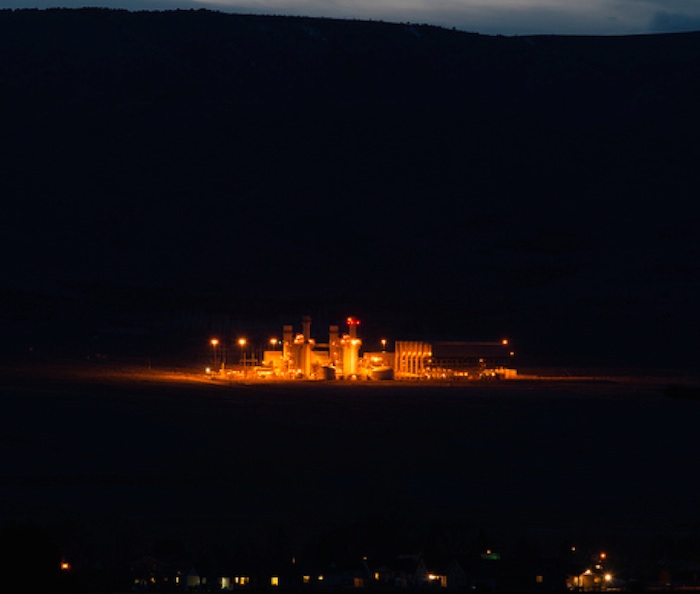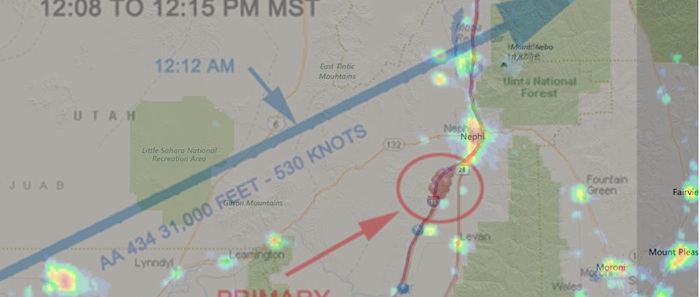.

As is his habit, Billy Cox found another UFO case to promote on his blog.1 The problem with his blog promotions is that he simply regurgitates the story being fed to him by the UFO investigator. As a news reporter, he seems to be uninterested in investigat- ing these UFO cases beyond what he is told. This is nothing more than story telling.
This case involves a sighting by an aircrew over Utah, who reported seeing a mile wide area of light in front of them. UFO inves- tigators then decided to determine if it was a real exotic object or not. The report that was produced looks good but, after closer examination, much of what is presented is subjective and interpreted with only one solution in mind.
The event
According to William Puckett’s site, the first his group became aware of the event was when a radio host was monitoring air traffic communications. He had reported to Utah MUFON that an aircrew of a commercial flight had seen a UFO off to the right near the town of Nephi, Utah. This object supposedly paced the aircraft for several minutes.
Investigators filed a FOIA, which revealed that the airliner was flight 434 en route from San Francisco to Philadelphia. The time of the event was between 12:12 and 12:13 AM MST. Puckett’s report has the recording of the conversation:
434: “ You wouldn’t happen to know what this bright orange square we are flying over is, would ya?” ATC: “No. That’s a good question..I am not sure what...is it off to your right side?”
434: “It is, like, directly off our nose right now. It is right below us. We have been watching it for a while, like, I don’t know what it is. It is a perfect square and it is bright orange. What town are we next to. This town off our 2 O’clock low.”
ATC: American 434, that is Nephi...Nephi, Utah2
This is the actual report of the aircrew, which, by itself, does not sound very spectacular and is different than what was originally reported by the person who was listening in on the radio traffic.
The UFO investigation
The investigation focused much of its attention on obtaining radar data to confirm the UFO event. It seems that UFOlogists like to use radar data as some form of ultimate proof that UFO events are real. However, they tend to follow Philip Klass’ UFOlogical principle #9
Whenever a light is sighted in the night skies that is believed to be a UFO and this is reported to a radar operator, who is asked to search his scope for an unknown target, almost invariably an “unknown” target will be found. Conversely, if an unusual target is spotted on a radarscope at night that is suspected of being a UFO, an observer is dispatched or asked to search for a light in the night sky, almost in- variably a visual sighting will be made.3
Puckett obtained FAA radar data and noted that between 12:08 and 12:15 AM there were multiple radar contacts to the southwest of the town of Nephi along Interstate 15.
Puckett states that these targets represent some true targets and they are not due to anomalous propagation. Because of the dis- tance from the radar, it indicates that the contacts were very large. To rule out AP, he presents us with radiosonde data to demonstrate this is true.
Puckett also feels that the ATC talking to flight 434 had the UFO on his radar:
In the recorded conversation starting just after 12:12 AM the crew was talking about their sighting and the FAA responded “you mean to the right.” How did they know that? They knew because they had it on radar.4
He suggested that the redacted part of the tape contained all the pertinent information where the ATC described having the UFO on radar.
Puckett concludes that “The radar shows a dense area of returns at the exact position and time reported by the pilot.”5 While Puckett sounds convinced, I believe he has overstated his case.
The radar data is not as convincing as advertised
Idiscussed this case with several skeptics and we had determined that Puckett took liberties in his analysis and there were some mistakes about his radar data analysis.
The first thing I noticed was that his radiosonde data was from the 0000Z and not the time of the event (0712Z). Therefore, it can not conclusively rule out anomalous propagation (AP). Another problem with his use of radiosonde data is that it is one sample point along the entire radar beam stretching from the radar site to Nephi. A temperature inversion at some point along the 88 miles from radar antenna to target might produce the results. Stating he has conclusively eliminated the possibility that these targets are not AP is not entirely accurate.
It is hard to analyze his targets without more data. Is it common to see these targets at this location at night? How strong were the returns? Neither of these questions were answered but there are several factors that Puckett does not consider:
• If these were the radar returns from a UFO that could be seen from 31,000 feet and was a mile wide, why wasn’t it reported by travelers on Interstate 15, which ran right through the area of the targets? It was late at night but there are vehicles on a major interstate late at night. State troopers, truckers, and local police surely would have noticed such an obvious target hovering in the sky.
• The region of the targets was to their right, at a relative bearing of about 60 degrees at the time they were describing the object being in front of them. It was also about 12 miles away at closest approach, which means that the could not have flown over it. Contrary to what Puckett states, the radar data does not match the visual report by the aircrew. It is not an “exact match”.
These important points tend to indicate that the UFO was not detected by radar and was not visible unless one were in the air.
The probable explanation
Puckett’s report does make mention of a possible solution but he dismisses it:
One investigator believes that the crew sighted lights from a local power point (Currant Creek Plant – Mona, UT). To me this doesn’t explain the sighting as the conglomerate of radar returns suggests something unusual. Also I would expect that the same crew had flown this same route before. If this was true, why would they ask the FAA about the location?6
As mentioned, the radar data is not a match and can not be used as confirmation that the “bright orange square” was an airborne object. Puckett’s other argument that the pilots would be quite familiar with the power plant does not consider some possibilities:
1. The aircrew never flew this route before.
2. The aircrew had flown over the region but not under conditions that the lighting was readily visible (clouds, ground fog, etc.).
3. The aircrew had never noticed the lights before. Imagine how many times you drive to work and never notice certain things un- til one day, you do notice it. Like the pilots you were too focused on the road (in the pilot’s case, the sky) to focus your attention on something that is not of serious concern.
.

Like the radar data, Puckett turns assumptions into facts in order to satisfy the need to turn this UFO into something extraordinary.
Puckett should have looked closely at the Currant Creek Power Plant explanation. This image to the right shows the flight path of 434 starting at 0712Z (1212 MST). Notice that the plane flew directly over the Current Creek power plant at roughly 07:13:30 Z. This is about the same time the aircrew stated that the bright orange square was directly below them!
.

The general radius of the power plant’s coverage is about 1 mile, which matches the estimate in size by the aircrew.
This photo by Zachery Jensen shows the power plant at night.7 Compared to the town of Mona (in the foreground), it is extremely well illuminated.
.

When I transposed Puckett’s aircraft flightpath on top of a light pollution map for Utah 8, we see the aircraft flying directly over a large light source at the time it was flying over the power plant!
.

Conclusions
The reaction of the aircrew should be a telltale sign of how significant this UFO was to them. They simply asked what the source of the lights were in front of them. They even stated that they were passing over it but did not seem concerned about any sort of possible collision. If their light source was truly airborne, they would have expressed a great more concern in their communications and would have asked the ATC for a new course or what the identity of the aircraft was. This indicates the object was perceived by the aircrew as being on the ground. The information all indicates that the Currant Creek Power Plant is the most likely source of the mile-wide lights.
Quelle: SUNlite 3/2016
9199 Views
